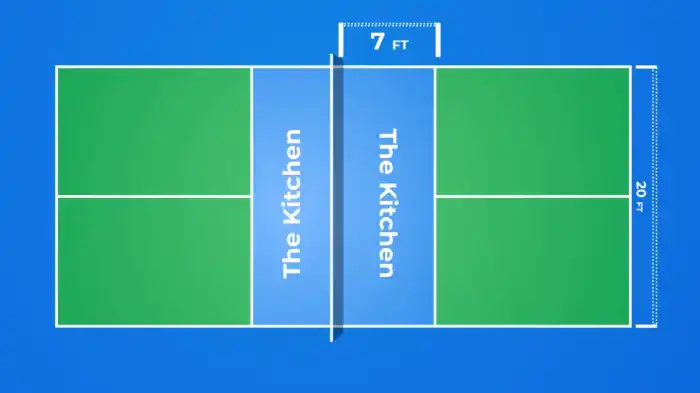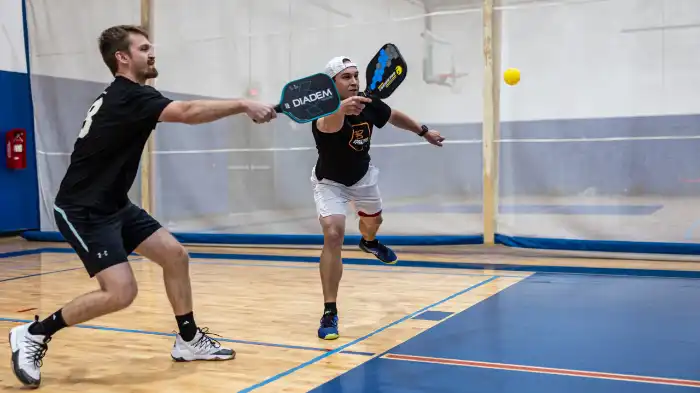Pickleball is a fast-paced racket sport that combines elements of tennis, table tennis, and badminton. It is played on a court divided by a net, and the objective is to hit a small plastic ball over the net and into the opponent’s court. A crucial part of the game is the kitchen, also referred to as the non-volley zone.
If you want to know what is the kitchen in pickleball, then you are at the right place. In this blog post, we are going to discuss the meaning of the kitchen in pickleball, along with its role and rules. Then, we are going to provide essential tips for mastering this sport in the kitchen area of the court.
What Is the Kitchen in Pickleball?
The kitchen refers to the area on each side of the pickleball net, extending 7 feet from the net on either side. It is marked by two parallel lines perpendicular to the net. As per the official rules, players are not allowed to enter the kitchen unless the ball bounces in it first. It is also known as the “Non-Volley Zone.“

The Role of the Kitchen in Pickleball
The kitchen plays a vital role in pickleball gameplay. It is strategically designed to prevent players from smashing or volleying the ball close to the net, ensuring more prolonged rallies and fostering precision and strategy. The emphasis on accurate ball placement and the limited space in the kitchen demand skill and finesse from players.
Kitchen Rules in Pickleball
Here are some key rules related to the kitchen in pickleball:
- Non-Volley Zone (Kitchen): Players cannot hit the ball in the air while standing in the non-volley zone, which is a 7-foot area from the net on both sides. This rule is designed to prevent players from executing volleys (hitting the ball in the air without letting it bounce) too close to the net.
- Foot Faults: Players must also be careful not to step into the non-volley zone while hitting the ball. If any part of a player’s foot goes into the kitchen, it is considered a fault.
- Volleying: Players can only volley (hit the ball in the air without letting it bounce) when they are located behind the non-volley zone. This means that they must step back from the net before hitting a volley shot.
- Bounces in the Kitchen: If the ball bounces in the non-volley zone, players are allowed to enter the kitchen and hit the ball. However, they must exit the kitchen before hitting the ball in the air.
Understanding and following these rules related to the non-volley zone or kitchen is crucial for fair play in pickleball. It adds an element of strategy and finesse to the game, as players need to carefully manage their position on the court, especially near the net.
Tips for Mastering Pickleball in the Kitchen(Non-volley Zone)
Mastering the non-volley zone, commonly referred to as the kitchen, is essential in becoming a skilled pickleball player. Here are some tips to help you excel in this area:
Footwork is Key: Develop quick and precise footwork to move in and out of the kitchen efficiently. Being able to navigate this zone swiftly allows you to maintain a strategic position during play.

Stay Back During Volleys: Don’t try to hit the ball in the air while you’re in the kitchen. Instead, take a step back behind the non-volley zone to make your volleys. This helps you to steer clear of mistakes and allows for more precise control over your shots.
Learn the Soft Game: Master soft shots, such as dinks and drops, which are effective near the kitchen. These shots help to control the pace of the game and can be particularly advantageous when playing close to the net.
Practice Groundstrokes: Improve your groundstroke technique to confidently hit the ball from behind the non-volley zone. This skill is crucial for maintaining a strong offensive and defensive game without violating kitchen rules.
Anticipate Opponents’ Shots: Pay attention to your opponents’ positioning and shots to anticipate where the ball is likely to land. This foresight enables you to position yourself optimally within the non-volley zone.
Frequently Asked Questions
The kitchen, also known as the non-volley zone, is a seven-foot space on each side of the pickleball net. Players cannot step into this area and hit a volley, ensuring fair play and avoiding overly aggressive shots. It is a crucial part of the game, promoting strategic and controlled gameplay.
Staying out of the kitchen is vital because it prevents players from executing powerful smashes close to the net. This rule ensures a balanced and skillful match by encouraging players to practice dinking and drop shots, which require finesse and control rather than brute force.
Footwork is crucial in the kitchen area of pickleball because it enables players to move swiftly in and out of the non-volley zone, maintaining an advantageous position on the court. Precise footwork is essential for executing strategic plays, avoiding faults, and ensuring effective shot placement near the net.
No, players can only volley from behind the non-volley zone to maintain fair play and strategic positioning.
Conclusion
In conclusion, understanding what is the kitchen in pickleball is pivotal for anyone aspiring to master this dynamic sport. The kitchen or non-volley zone, acts as a strategic battleground where players must balance precision and finesse. Adhering to the rules governing this area ensures fair play and encourages a strategic approach, emphasizing accurate ball placement and skillful footwork.
As players navigate the 7-foot space near the net, they develop the ability to make accurate volleys and realize how important it is to stay out of the kitchen in certain situations. Becoming adept at handling the kitchen not only makes rallies last longer but also improves a player’s knack for gentle shots and well-planned groundstrokes.

